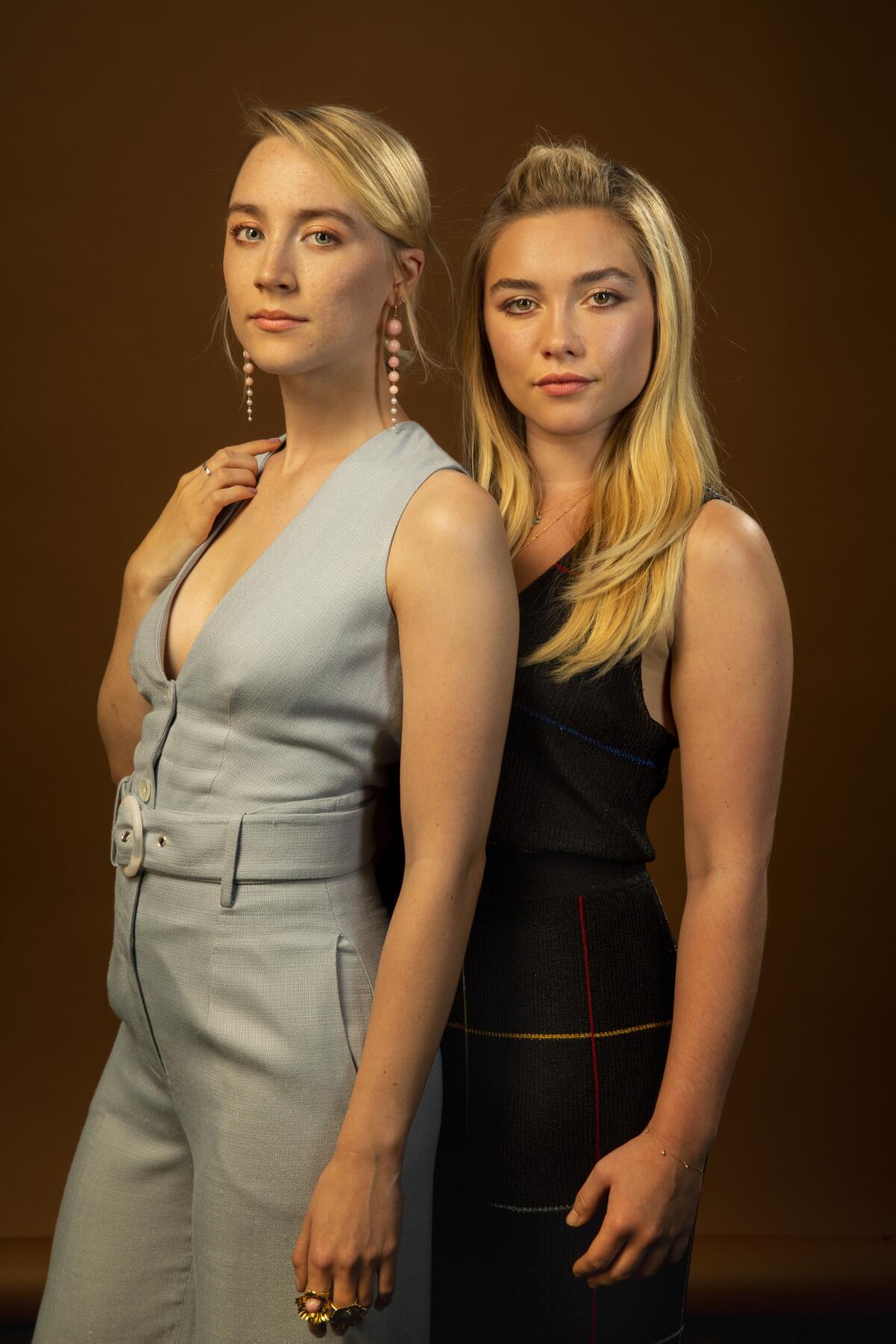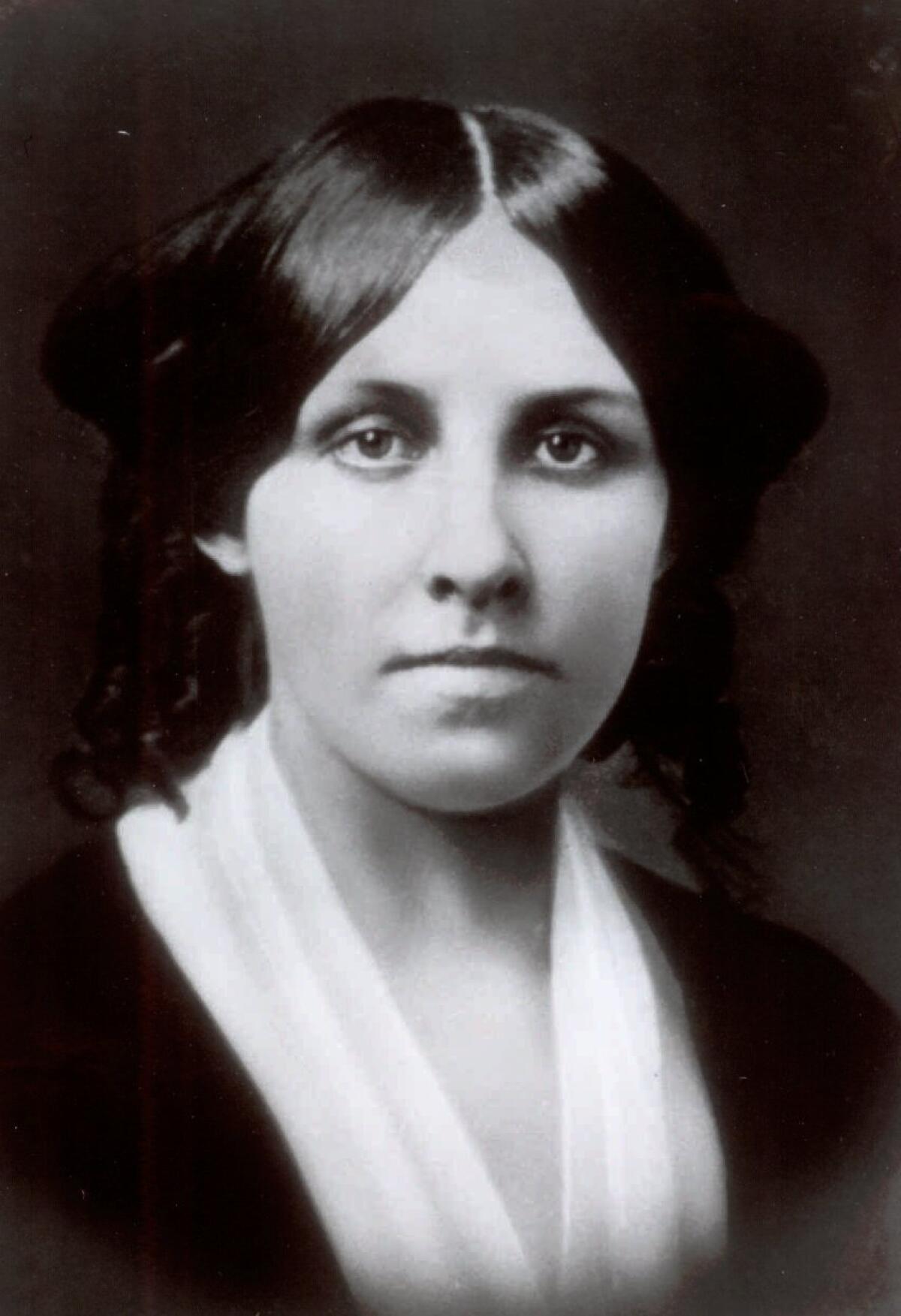How Saoirse Ronan and Florence Pugh updated ‘Little Women’ for modern feminists

- Share via
Florence Pugh is rapidly swiping her index finger across her iPhone, searching for Pam.
“Hang on, hang on,” she says. “I’m going to get it. Where’s Pam? Oh, this is killing me.”
Pam is not the name of the actress’ beloved dog, or even one of her three sisters. Pam is the name that Pugh assigned to her costar, Saoirse Ronan, on the set of Greta Gerwig’s upcoming “Little Women” adaptation.
Pugh bestowed the alter-ego upon Ronan after shooting one of the most memorable scenes from Louisa May Alcott’s classic novel: when Jo March (Ronan) reveals she has secretly cut off her long tresses. Her three sisters are horrified — “Oh, Jo, how could you? Your one true beauty!” cries Amy (Pugh), the youngest sibling — even though Jo sacrificed her hair to earn money for their ailing father’s recovery.
Enter Pam. When she started filming, Ronan had lustrous blonde locks that curled nearly to her waist. Post-haircut, however, she was forced to don an unsightly wig: It’s almost a mullet, but more of a shag with an unkempt Owen Wilson vibe to it.
“And that’s when Flo came up with this character called Pam,” recalls Ronan, 25. “Pam is from Australia, and Pam’s got a lot of opinions about what’s going on.”
“She knits in between takes,” Pugh, 23, says, suddenly sounding as if she’s from Melbourne instead of Oxfordshire. “Saoirse would sit with her Ugg slippers twiddling her foot between takes with this ridiculous look, and it was wild.”
She continues to scroll through photographs, frantically seeking proof of Pam and pausing only to take bites of a chocolate croissant. Ronan sits across from her costar at the Chateau Marmont, and after ordering a pastry of her own, dutifully starts to answer most of the questions about “Little Women.”
Opening Christmas Day and already generating deafening awards buzz, it’s the seventh feature film version of Alcott’s 1868 novel. Unlike her predecessors, Gerwig — who wrote and directed the project — has taken a non-linear approach to the story, viewing the the March sisters’ formative childhood days in Concord, Mass., through the lens of adulthood.
While all four sisters follow decidedly distinct paths into womanhood — Jo wishes to defy societal conventions by remaining unmarried; Meg wants nothing more than to find a husband and bear children — Gerwig’s adaption attempts to treat all their choices with respect.
Ronan first met Gerwig when she starred in Gerwig’s directorial debut, “Lady Bird,” and she speaks about the filmmaker with the earnest reverence of a freshman who admires a senior. She loves that “Little Women” was directed “not only by a filmmaker who’s already become so important for our generation but a lady and one who was pregnant at the time.”
“The four girls who lead this story are all very, very different, and they all allow a young girl to see themselves,” continues Ronan, who is joined by Emma Watson (Meg) and Eliza Scanlen (Beth) in the film. “ ‘Little Women’ gives you the opportunity to relate to aspects of all the girls, because they’re all different ages and want different things. It means that you can grow up with the story and say —”
Ronan halts as Pugh, finally having located the picture she was looking for, excitedly shows off her phone.
“Oh, you just want to show Pam,” Ronan says, laughing. “You don’t give a [crap].”
“I do give a [crap],” Pugh says. “But are you ready for Pam?”

It’s easy, in this moment, to understand why Gerwig cast the two actresses in their respective roles. Ronan has been preternaturally mature since she was a girl, earning an Academy Award nod at 13 for one of her first movie roles in 2007’s period drama “Atonement.” The Irish star has spent an inordinate amount of time on the award circuit over the last few years, starting with “Brooklyn” in 2015, “Lady Bird” the next year, followed by “Mary Queen of Scots” and now “Little Women,” for which she is widely expected to earn her fourth Oscar nomination. She’s comfortable in industry settings and with those decades her senior, growing self-assured enough to bypass her agents and ask Gerwig directly if she could play Jo March.
“We were at the Independent Spirit Awards, and she just said, ‘I’ve never done this before, but I have to play Jo. I’m the only one who can play Jo,’ ” remembers Gerwig. “It felt like such a Jo thing to do, to declare your space and say ‘That’s mine.’ And she was right. It’s like somebody standing beside you, looking at a chair, pointing at it and saying ‘That’s a chair.’ She was extraordinary in the role and was extraordinary from the first second.”
Pugh, meanwhile, is essentially a newcomer in Hollywood — racking up credits at a rapid pace and still relatively unguarded. Her first starring role, in a 2016 British adaptation of “Lady Macbeth,” ended up earning her a BAFTA nomination, and shortly after, she landed the lead in the Dwayne Johnson-produced wrestling flick “Fighting With My Family.” She was about to head off to shoot the thriller “Midsommar” when Gerwig was putting together “Little Women,” and put herself on tape at the director’s request.
“We wanted something we could show everyone, because she is less known,” says Gerwig. “I needed her to be in the same weight class as Saoirse — someone who could really be equally formidable. And she was that person. I moved the shoot for her because I wanted her to be in it so badly.”
We’ve compiled a list of films set to premiere this holiday season, from Nov. 6 through Jan. 17.
In the last major adaptation of “Little Women” — the 1994 Gillian Armstrong version deeply cherished by millennials — Amy was played by two actresses: Kirsten Dunst as a girl and Samantha Mathis as a woman. But Robin Swicord, who wrote that version of the film and served as a producer on Gerwig’s iteration, said Sony’s Columbia Pictures was “looking for a clean break from the ’90s version.”
“We said: ‘It’s been 25 years, and we’re all about the new generation having their own ‘Little Women,’ ” says Swicord. “We wanted to make sure we were making something that was very different. With Amy, in my version, we felt like she was a little girl tagging along with all her malapropisms, and we couldn’t quite wrap our brain around the time jump. But because Greta focuses a lot of on adulthood and shows childhood in reminiscence, you don’t question it.”
Ronan says she “grew up” on that version of the film, but Pugh was more familiar with Alcott’s book. Her grandmother would read it to her every weekend, creating unique voices for all the characters.
“She hated Amy,” Pugh says. “She’d always say, ‘What a wicked, wicked girl!’ It’s so easy to love Jo, because she represents everything that we want to be. She has a voice, and she goes out there and she doesn’t really give no [craps]. But coming to the book later on in my life, I realized that every single thing Amy says is perfect. I love a naughty person in a book. It’s my most favorite thing to see someone create havoc. We all want to be Jo, but realistically, I definitely think there are probably more pieces of me in Amy.”
Amy, Gerwig theorizes, has long gotten “short shrift” by the public, which has often focused on her vanity. As a girl, Amy tries to mold her nose so that it will have another shape, and she is open about her desire to marry a rich man and have nice things. Jo, meanwhile, infamously turns down a marriage proposal from a handsome, wealthy suitor — Laurie, played in the new film by Timothée Chalamet — and is more interested in becoming a great writer than centering her life around a man.
“But I think Amy is so much more profound than people give her credit for,” Gerwig says. “And in terms of femininity, neither one of them are feminine in the sense of having it merge with their identity. Both of them are masculine. Jo wants to be a boy, and Amy performs femininity because it’s expedient for them to get what they want.”
That’s the way Swicord sees the characters too. In Gerwig’s screenplay, the producer says, she views Amy as a “practical person dealing with the world she inherited” — one in which she’s just trying to grow up and find her own identity separate from her powerful, creative older sister. Swicord then alludes to a 1991 essay written by Catharine A. MacKinnon in the Yale Law Review — “From Practice to Theory, or What is a White Woman Anyway?” — “essentially a legal discussion about how women treat each other.”
“She writes that we will never really be able to change the world — or laws for women — if we don’t accept that blonde woman who is flipping her hair and flirting with the men,” says Swicord. “Men in the 1980s would have called these women ‘bimbos’ — a word I’m glad has gone away, because it’s appalling. And she’s so right. We have to embrace Amy and not judge her as superficial or materialistic.”
But Gerwig’s take on Jo evolved for 2019 too. She and Ronan had discussions about how the character was a mix of both Jo and Alcott, and the actress read “Marmee & Louisa,” a dual biography of the author and her mother that she says offered necessary insight into Alcott’s mind.

“It was the most helpful reference point for me,” Ronan says. “It talks a lot about Louisa’s dad and how he never went out and earned any money. When she started to do well, he was always very, very hard on her. He was great with the other girls but not with her, I think because she was sort of this asexual or bisexual tomboy girl who wrote about murderers. I think it’s quite powerful — especially for that community now — that an author who wrote a beautiful, romanticized American classic could have potentially been at least bisexual. She married off her sisters and her lead character to a man, and the fact that the woman behind all of that wasn’t necessarily interested in men? I think for her own spirit, she needed to paint her life in this sort of light, as opposed to what it was actually like. And that’s kind of heartbreaking, you know?”
Together, the director and actress talked about the legions of famous female artists who have said publicly they are influenced by Jo and Alcott: Patti Smith, J.K. Rowling, Simone de Beauvoir, Elena Ferrante. “And they don’t say ‘Little Women’ is their favorite book because Jo marries a man at the end,” Gerwig says. “They like it because she’s an author, and she owns it. We wanted that to come through.”
In Concord, the cast arrived two weeks before shooting to rehearse, first researching the transcendentalist movement and then working on the dialogue together. Gerwig wrote the screenplay in ultra-specific fashion, with many lines of dialogue overlapping so that they would be read on top of one another. It was like being in a “five-piece band,” Ronan says, with everyone playing a different instrument. “That’s why we ended up being so close, I think, because we really relied on each other a lot more than a normal film where you wait for someone to say their line,” she says. “We knew what our part was and we had to be on it.”
Pugh, however — still in the midst of shooting “Midsommar” — was the one cast member who had to miss the rehearsal period. Though the director sent her audio recordings of the day’s work so she didn’t feel left out, Pugh ultimately came to feel like the separation from the cast was helpful.
“At first we were like, ‘Oh, God, she’s not going to be here,’ and it felt like we all needed to be together,” says Ronan. “But actually, you said it when you got there, Flo — Amy is sort of going on her own path. Amy and Jo are quite similar, actually, in that Jo’s like ‘I’m going to do this thing.’ And Amy’s, like, ‘[Screw] you, I’m going to do this thing.’ They want different things, but they’re both very defiant in spirit.”
“They both have very stubborn personalities,” adds Pugh. “But I don’t think they’re enemies or rivals.”
“I think they’re both as feminist as each other,” Ronan continues, “because they both know what they want and stand by that.”
Off-screen, the young cast has developed a sisterly bond too. After a week of unveiling the film to press and guild members in L.A., Pugh says she texted a video to Scanlen — who could not be in town due to a work conflict — telling her “not to have FOMO,” or the fear of missing out. And though Pugh says she has yet to ask Ronan for awards season Cliffs Notes, the elder actress says she’s proudly been watching Pugh navigate through the flurry of media attention.
“I mean, I don’t think of you as being, like, new on the scene or whatever,” Ronan says. “But what’s exciting about watching you do this, Flo, is that I don’t think anybody has seen you like this before. She’s so funny in this movie, and people haven’t seen that yet.”
“No, no, they haven’t,” Pugh agrees. “I think people are reacting [positively] because it is so different — they’re like, ‘What? You can be a kid now?’ Not one film of mine has gone to the same audience.”
“It’s been really nice to have you there during Q&As,” Ronan says. “And the thing about it is, friends of mine have asked: ‘Do you think “Little Women” is going to go all the way?’ And I tell them, ‘You know, you really can’t tell.’ We just have to be there together and go: ‘This is great for now.’ ”
More to Read
Only good movies
Get the Indie Focus newsletter, Mark Olsen's weekly guide to the world of cinema.
You may occasionally receive promotional content from the Los Angeles Times.










